
COVID-19: Why the Balance Between Freedom of Religion and Public Health Matters
P. T. Babie & Charles J. Russo
This article is part of our “Reflecting on COVID-19” series.
If you’d like to check out other articles in this series, click here.
As COVID-19 tightens its lethal grip on the globe, a palpable tension emerges between the authority of governmental officials in every state in the U.S. who have issued guidelines limiting social interactions to preserve the public health while recognizing religious exemptions, and individual rights to freedom of religion. Lawsuits in the United States have challenged the extent to which restrictions may, in the attempt to achieve the laudable objective of protecting the general welfare, limit freedom of religion by exceeding the scope of the lawful authority of public officials.1See Maryville Baptist Church v. Beshear, — F.3d —, 2020 WL 2111316 (6th Cir. May 2, 2020) (enjoining enforcement of the governor’s order forbidding drive-in services while ordering Church officials and congregants to comply with its social distancing and hygiene guidelines pending an appeal on the merits); Roberts v. Neace, Case No. 2:20-cv-00054 (6th Cir., May 9, 2020) (enjoining enforcement of the governor’s order banning in-person services at Maryville Baptist Church pending an appeal on the merits). See also, e.g., On Fire Christian Ctr. v. Fischer, — F. Supp.3d —, 2020 WL 1820249 (N.D. Ky. 2020); First Baptist Church v. Kelly, — F. Supp.3d — 2020 WL 1910021 (D. Kan. 2020); Gish v. Newsom, — F. Supp.3d —, 2020 WL 1979970 (C.D. Cal. 2020); First Pentecostal Church of Holly Springs v. City of Holly Springs Miss., — F. Supp.3d —, 2020 WL 1978381 (N.D. Miss. 2020); Cassell v. Snyders, — F. Supp.3d —, 2020 WL 2112374 (N.D. Il. 2020); Lighthouse Fellowship Church v. Northam, — F. Supp.3d —, 2020 WL 2110416 (E.D. Va., 2020); Cross Culture Christian Ctr. v. Newsom, — F. Supp.3d —-, 2020 WL 2121111 (E.D. Cal. 2020); Word of Faith Christian Center Church v. Whitmer, — F. Supp.3d —, 2020 WL 2213925 (W.D. Mich. 2020); Tabernacle Baptist Church, Inc. of Nicholasville, Kentucky v. Beshear, — F. Supp.3d —, 2020 WL 2305307 (E.D. Ky. 2020); Mark Anthony Spell; Life Tabernacle Church v. Edwards, — F. Supp.3d —-, 2020 WL 2219234 (M.D. La. 2020); Calvary Chapel of Bangor v. Mills, — F. Supp.3d —-, 2020 WL 2310913 (D. Me. 2020). The results have been mixed. Some judges have validated regulations that permit selected businesses—liquor stores and other commercial ventures, including drive through restaurants—to remain open as “essential services,” while forbidding worshipers from listening to communal religious services while sitting in parked cars with their windows rolled up and maintaining social distancing from other vehicles. This disparity in regulatory treatment of religious and other services led a judge in Kentucky to muse that if the sale of beer in liquor stores is essential, then why not freedom of religion?2On Fire Christian Ctr. v. Fischer, Ibid. at *7. The query matters.
There is no question that, as Attorney General Barr has said, “constitutional rights don’t go away in an emergency.” Indeed, U.S. equal protection analysis already provides for the careful judicial balancing of the general welfare and individual rights during emergencies. The standard approach allows judges to assess restrictions on fundamental rights so as to ensure that they are justified by compelling state interests and implemented in the least restrictive means possible. This balancing means that restrictions must be narrowly drawn to avoid unnecessarily limiting rights. Using this approach, rights remain protected. In the case of the current pandemic, balancing may mean that restrictions aimed at both “in-person” and “drive-in” communal worship may be found to be constitutionally permissible, aimed at achieving the justifiable governmental objective of preserving public health and the general welfare. Even so, relying on equal protection, some judges have invalidated these limits as insufficiently narrowly drawn by allowing drive-through restaurants and liquor stores to remain open while forbidding drive-in worship services without offering a compelling interest for the distinction.
Whatever the outcome in a specific case, balancing is important. Faraz Sanei explains that “religious freedom and health are both essential human rights that governments must guarantee. Faith leaders and community members undoubtedly play a critical role to ensure that their religious exercise does not put the health and safety of others in jeopardy. But those who are not “of faith” also have a responsibility to ensure that religious freedom is not sacrificed at the altar of unchecked state police power. And all of us, religious or not, have a civil and moral responsibility to act in a manner that does not negatively impact the rights of others.” According to Robin Fretwell Wilson, Brian A. Smith, and Tanner J. Bean, this is why as the pandemic rages on, we must remember that “individual actions have collective consequences notwithstanding what the law allows or prohibits”. We must always “lead by example, as so many congregations and people of faith have done[,]…to put others first.”
Yet, even when careful judicial balancing occurs, and when people of faith lead by example by curtailing their own individual rights to religious freedom, all people ought to retain an active interest in the potential for religious rights infringements and the governmental justifications offered for them. This essay explains why, drawing upon the Australian experience with the protection of fundamental rights.
We must understand that rights must be balanced and that people of faith ought to lead by example. But when does the exercise of power used during an emergency go too far?
It may surprise some to know that Australia provides almost no protection for fundamental rights and freedoms. Unlike the U.S. Bill of Rights or the Canadian Charter of Rights and Freedoms, no similarly comprehensive protections are enshrined in Australian law.3See Paul Babie & Neville Rochow, Feels Like Déjà Vu: An Australian Bill of Rights and Religious Freedom, BYU L. Rev. 821 (2010). Instead, only a very few rights are scattered throughout the Australian Constitution. One of these, s. 116, provides that the federal government “shall not make any law…for prohibiting the free exercise of any religion.” Even this provision, which is patterned after the First Amendment of the United States Constitution, has been interpreted so narrowly by the courts that it is next to meaningless as a protection for religious freedom. Current understandings of sec. 116 are similar to American First Amendment law following Employment Division v. Smith: A law of general application whose effect–though not its expressly stated purpose–is to restrict religion, would be found constitutional. Of course, state laws in the U.S., unlike Australia might afford greater protection for the free exercise of religion. But in Australia, only a law which takes as its express purpose the restriction of religious freedom runs afoul of sec. 116.4Krygger v. Williams (1912) 15 C.L.R. 366 (Austl.); Adelaide Co of Jehovah’s Witnesses v. The Commonwealth (1943) 67 C.L.R. 116 (Austl.); Kruger v. Commonwealth (1997) 190 C.L.R. 1 (Austl.). The upshot of this is that no law in the history of Australia has ever been found to violate this right.
The public gathering restrictions currently imposed in every Australian state, which do not expressly restrict public gatherings for religious worship, but certainly have that effect, are therefore very likely constitutional. In fact, in recent days, while Americans have been pursuing judicial redress for potential violations of the right to religious freedom, Australian religious leaders have implored governments to ease the restrictions and citizens have petitioned for them to be lifted. No process exists in Australia for the careful judicial balancing of the competing interests. In fact, no recourse at all is available other than imploring and petitioning the government. So while the restrictions may be entirely justifiable, no process independent of government forebearance exists for testing that conclusion.
To Australians expressing concern about the potential violations of religious freedom, one might respond along these lines: “Well, it is only a minor violation, for the time being, and it is necessary due to a public health emergency.” And that would of course be true. We must understand that rights must be balanced and that people of faith ought to lead by example. But when does the exercise of power used during an emergency go too far? And what happens to such restrictions once the emergency is over? In Australia, the government can always answer that it never goes too far, so long as its stated purpose is not the restriction of religious freedom, and that an emergency ends when it says it does. Individuals in Australia lose in almost every case.
Absent sufficient protections against governmental encroachments and a framework for the careful balancing of competing interests, not only might freedom of religion suffer, but also the entire spectrum of core fundamental rights and freedoms enjoyed in a free and democratic society
But remember that other than the ineffectual s. 116, no rights are protected in the Australian Constitution—no freedom of speech and assembly, no equality, no protection for property, no protection for due process of law. No framework exists for the careful balancing of any individual rights against the general welfare. So, while the Australian example is extreme, it is also real. That is why it ought to be taken seriously, because it demonstrates that the extent to which freedom of religion is protected serves as a bellwether of the need to do the same when what might for now seem to be legitimate and justifiable exercises of governmental power cross the line, becoming illegitimate, unjustifiable infringements on other rights and freedoms inherent to the rule of law. Absent sufficient protections against governmental encroachments and a framework for the careful balancing of competing interests, not only might freedom of religion suffer, but also the entire spectrum of core fundamental rights and freedoms enjoyed in a free and democratic society.
One need not be a science-fiction enthusiast to find examples of the sorts of restrictions governments around the world might soon consider as means to control the spread of COVID-19. Researchers at Oxford University, for instance, have already developed a mobile phone digital contact tracing app aimed at monitoring coronavirus transmission. Both Singapore and Australia are already using such technology. There is no doubt that tracking technology constitutes an important part of balancing the general welfare against individual rights, and that when we voluntarily use it, we lead by example in curtailing our own freedoms in the interests of the general welfare. But when we do, we should continue to ask: when do justifiable uses of new technology potentially interfere with legitimate privacy rights, and how will we balance the competing interests if they do?
The current governmental limits on freedom of religion in Australia and the United States aimed at controlling the spread of COVID-19 may very well be constitutionally permissible as an appropriate balance of the general welfare against individuals’ freedom of religion. Even so, if we fail to be concerned about the importance of the individual right and its careful balancing against other community interests, minor encroachments for the time being might imperceptibly creep far beyond the justifiable limitation of one right to affect many others.
It matters, then, whether we are in Australia, the United States, or elsewhere, that we understand the value of protecting fundamental rights, expecting judges to utilize a framework which makes possible the careful balancing of competing interests. Citizens must always lead by example. Doing so means knowing when to curtail our own rights when necessary to protect the general welfare. It also means retaining more than a passing interest in the ways in which governments restrict fundamental freedoms like religious freedom, and the justifications they offer for doing so. Otherwise, we may soon find that “if they take you in the morning, they will be coming for us at night.”5James Baldwin, ‘An Open Letter to My Sister, Angela Y. Davis’ in If They Come in the Morning: Voices of Resistance 19, 23 (Angela Y. Davis, Ruchell Magee, the Soledad Brothers and Other Political Prisoners (Eds.), repr. 2016).

P. T. Babie is Adelaide Law School Professor of the Theory and Law of Property, Adelaide Law School, The University of Adelaide, Australia.

Charles J. Russo is Panzer Chair in Education & Director, Ph.D. Program in Educational Leadership, School of Education and Health Sciences, Research Professor of Law, School of Law, University of Dayton, USA. Russo is also an Adjunct Professor in the Law School of the Sydney campus of Notre Dame University of Australia.
Recommended Citation
Babie, P. T. and Charles J. Russo. “COVID-19: Why the Balance Between Freedom of Religion and Public Health Matters.” Canopy Forum, May 18, 2020. https://canopyforum.org/2020/05/18/covid-19-why-the-balance-between-freedom-of-religion-and-public-health-matters/

